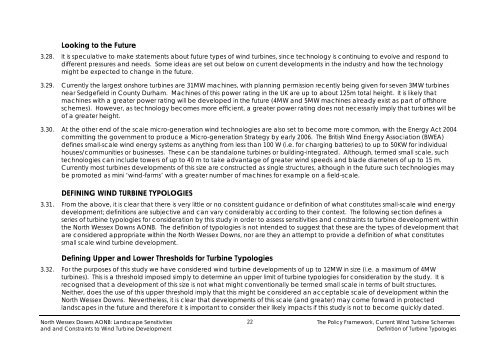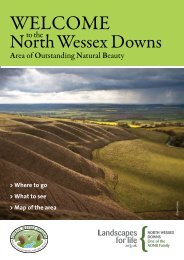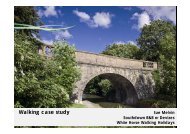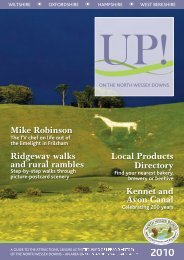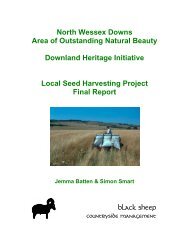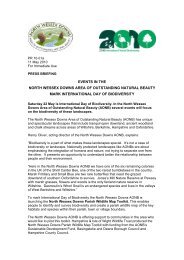A Study of Landscape Sensitivities and Constraints to Wind
A Study of Landscape Sensitivities and Constraints to Wind
A Study of Landscape Sensitivities and Constraints to Wind
- No tags were found...
You also want an ePaper? Increase the reach of your titles
YUMPU automatically turns print PDFs into web optimized ePapers that Google loves.
Looking <strong>to</strong> the Future3.28. It is speculative <strong>to</strong> make statements about future types <strong>of</strong> wind turbines, since technology is continuing <strong>to</strong> evolve <strong>and</strong> respond <strong>to</strong>different pressures <strong>and</strong> needs. Some ideas are set out below on current developments in the industry <strong>and</strong> how the technologymight be expected <strong>to</strong> change in the future.3.29. Currently the largest onshore turbines are 31MW machines, with planning permission recently being given for seven 3MW turbinesnear Sedgefield in County Durham. Machines <strong>of</strong> this power rating in the UK are up <strong>to</strong> about 125m <strong>to</strong>tal height. It is likely thatmachines with a greater power rating will be developed in the future (4MW <strong>and</strong> 5MW machines already exist as part <strong>of</strong> <strong>of</strong>fshoreschemes). However, as technology becomes more efficient, a greater power rating does not necessarily imply that turbines will be<strong>of</strong> a greater height.3.30. At the other end <strong>of</strong> the scale micro-generation wind technologies are also set <strong>to</strong> become more common, with the Energy Act 2004committing the government <strong>to</strong> produce a Micro-generation Strategy by early 2006. The British <strong>Wind</strong> Energy Association (BWEA)defines small-scale wind energy systems as anything from less than 100 W (i.e. for charging batteries) <strong>to</strong> up <strong>to</strong> 50KW for individualhouses/communities or businesses. These can be st<strong>and</strong>alone turbines or building-integrated. Although, termed small scale, suchtechnologies can include <strong>to</strong>wers <strong>of</strong> up <strong>to</strong> 40 m <strong>to</strong> take advantage <strong>of</strong> greater wind speeds <strong>and</strong> blade diameters <strong>of</strong> up <strong>to</strong> 15 m.Currently most turbines developments <strong>of</strong> this size are constructed as single structures, although in the future such technologies maybe promoted as mini ‘wind-farms’ with a greater number <strong>of</strong> machines for example on a field-scale.DEFINING WIND TURBINE TYPOLOGIES3.31. From the above, it is clear that there is very little or no consistent guidance or definition <strong>of</strong> what constitutes small-scale wind energydevelopment; definitions are subjective <strong>and</strong> can vary considerably according <strong>to</strong> their context. The following section defines aseries <strong>of</strong> turbine typologies for consideration by this study in order <strong>to</strong> assess sensitivities <strong>and</strong> constraints <strong>to</strong> turbine development withinthe North Wessex Downs AONB. The definition <strong>of</strong> typologies is not intended <strong>to</strong> suggest that these are the types <strong>of</strong> development thatare considered appropriate within the North Wessex Downs, nor are they an attempt <strong>to</strong> provide a definition <strong>of</strong> what constitutessmall scale wind turbine development.Defining Upper <strong>and</strong> Lower Thresholds for Turbine Typologies3.32. For the purposes <strong>of</strong> this study we have considered wind turbine developments <strong>of</strong> up <strong>to</strong> 12MW in size (i.e. a maximum <strong>of</strong> 4MWturbines). This is a threshold imposed simply <strong>to</strong> determine an upper limit <strong>of</strong> turbine typologies for consideration by the study. It isrecognised that a development <strong>of</strong> this size is not what might conventionally be termed small scale in terms <strong>of</strong> built structures.Neither, does the use <strong>of</strong> this upper threshold imply that this might be considered an acceptable scale <strong>of</strong> development within theNorth Wessex Downs. Nevertheless, it is clear that developments <strong>of</strong> this scale (<strong>and</strong> greater) may come forward in protectedl<strong>and</strong>scapes in the future <strong>and</strong> therefore it is important <strong>to</strong> consider their likely impacts if this study is not <strong>to</strong> become quickly dated.North Wessex Downs AONB: <strong>L<strong>and</strong>scape</strong> <strong>Sensitivities</strong> 22The Policy Framework, Current <strong>Wind</strong> Turbine Schemes<strong>and</strong> <strong>and</strong> <strong>Constraints</strong> <strong>to</strong> <strong>Wind</strong> Turbine Development Definition <strong>of</strong> Turbine Typologies


